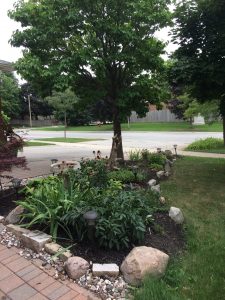
I created a flower bed under a French Ivory Lilac Tree. I cleared the grass and put in a foot and a half of triple mix soil. I planted hostas, bleeding hearts, Jacob’s ladder, coral bells in the shady area and put in Iris, peonies, bloodgood Japanese tree, spiderwort, lavender, hardy hydrangea, moms in the sunny areas. It looked great for the first year and second year and now it is being strangled by the root system that I think is from the tree; my hostas did not come out properly etc. Is there a suggestion on how to keep the root system at bay or is there a suggestion on what kind of plants I can put under the tree that won’t get strangled.
Thank you for contacting the Toronto Master Gardeners with your inquiry about planting under your Ivory Silk Lilac tree.
Trying to grow perennials under trees is problematic for a number of reasons. First, the area under the tree does not receive enough sunlight for plant material once the tree has leafed out. Secondly, the tree canopy prevents rainfall from reaching the soil and lastly, the tree’s roots compete with grass and other plants for water and nutrients.
From my research I have found that Ivory Silk Lilac surface roots are usually not a problem. https://hort.ifas.ufl.edu/database/documents/pdf/tree_fact_sheets/syrretb.pdf
That being said, if you remember “right plant, right place” you will be guaranteed success. The best perennials for under trees are ones that are adapted to dry shade. The Toronto Master Gardeners have a Garden Guide Perennials for Shade in Dry and Moist Areas which lists perennials that are suitable for the area.
You might also consider planting bulbs. Bulbs make an excellent choice since they will bloom before the tree leafs out.
Another possibility is native plants such as wild ginger or sweet woodruff. These plants often naturally grow as understory plants in woodland settings. The city of Guelph has an excellent website Native and Drought Tolerant Plants that gives a list of native plants capable of growing in dry shade.
The biggest mistakes that gardeners make is to plant for an instant garden. This results in a garden that may look good for the first two years, however very quickly the garden will become overgrown and each perennial will be competing for root space and nutrients. Therefore, when purchasing plants make sure to note the mature size of the plants and space them accordingly. This will give each perennial ample room to reach their mature size without competing with the surrounding plants. For example, the Japanese Bloodgood tree that you planted will reach a mature size of 15 -20ft tall by 15ft wide. This tree will eventually spread out over your walkway.
Also, it is always best to amend your soil with a yearly application of organic material such as compost.
Lastly, you might find the following website of use: Planting Under a Tree

